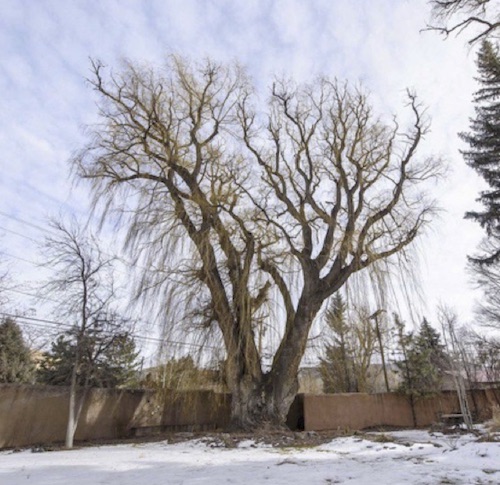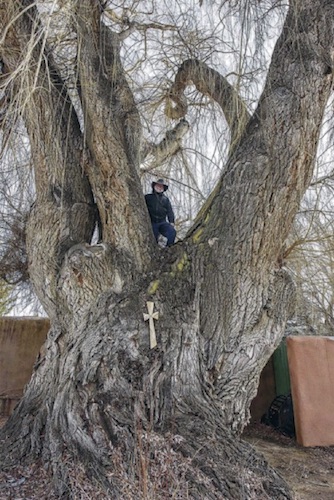 Goodding’s willow tree in Taos, New Mexico is both the state and national champion for its species at 110 feet tall and 351 inches in circumference.
Goodding’s willow tree in Taos, New Mexico is both the state and national champion for its species at 110 feet tall and 351 inches in circumference.
 Local arborist, Paul Jones, nominated it in the Big Tree Program (photo credit Santa Fe New Mexican).
Local arborist, Paul Jones, nominated it in the Big Tree Program (photo credit Santa Fe New Mexican).
Question:
Are trees immortal?
- 2nd Grade Student at La Promesa Elementary, Veguita, NM
Answer:
Sadly, no. Even under the best possible circumstances, trees cannot live forever. Many trees can have impressively long lifespans, though. Of the top four oldest documented trees in New Mexico, one of them is right there near you in Socorro County: a Chihuahua white pine in the San Mateo Mountains that is over 600 years old. The others are a Douglas fir at El Malpais that is about 1,275 years old, a limber pine about 1,670 years old, and a Rocky Mountain juniper at over 1,900 years old.
One famous old tree was another Douglas fir near Grants named Yoda that was known to be over 650 years old and was only 7 feet tall. Yoda died in 2014, and the documented cause of death was a combination of increased temperatures and drought.
Notice anything that those trees have in common? They are all evergreen trees. In fact, on a list of old trees published by the non-profit Rocky Mountain Tree-Ring Research group, the top ten oldest trees are all evergreens, with a bristlecone pine in the White Mountains of California taking the prize at over 5,000 years old and counting. The other trees include more bristlecones, a cypress, several Sequoia trees, and a juniper.
One reason evergreens tend to live longer than deciduous trees is that needles (modified leaves) in evergreens are able to keep photosynthesizing in the winter (at a low rate) when deciduous trees have lost all of their leaves.
Sugar and oxygen are products of photosynthesis in plants. Simply speaking, photosynthesis is the process of converting carbon dioxide and water into sugar and oxygen using light as the energy source. So, if there is plenty of carbon dioxide, water, and light, shouldn’t they be able to keep photosynthesizing sugars forever?
Not necessarily. One reason is that photosynthesis is only part of the story. Photosynthesis produces sugars (aka carbohydrates), but plants cannot use that sugar directly to grow. They have to convert the sugars made by photosynthesis into another form of energy that they can actually use. This process is respiration. During respiration, oxygen is needed to break the sugar down and produce carbon, water, and a usable form of energy called ATP (adenosine triphosphate).
As trees get bigger and older they are able to produce more leaves to support more photosynthesis and respiration, but they also require more and more energy to keep up. Over time, rates of photosynthesis and respiration slow down in trees. This is at least partly due to the fact that water, nutrients, and sugars have to travel farther as the plant grows, and the routes often become more winding as tree trunks branch out. This “path tortuosity,” coupled with gravity, makes water transport less and less efficient over time. Also, as trunks get bigger after maximum height has been reached, trees have more mass to maintain but not necessarily more leaves. These changes, and others, result in limited sugar and limited energy so that eventually the tree’s ability to tolerate changes in the environment is reduced. That’s why, for example, trenching in the root zone on a young tree might be stressful, but not deadly (depending on the severity of damage), whereas an older tree is more likely to die.
Increased care for older trees is helpful! If you want a tree in your yard to live as long as possible, think twice before doing anything that will cause stress, like pruning or peeling the bark. Also consider irrigating more as the tree ages, but not necessarily more frequently. Roots need oxygen, and therefore the soil still needs to dry out between waterings (unless you never water, and then increased frequency is advisable), but think more about saturating the root zone, which may be several times wider than the tree height and about 3 feet deep, not just at the base of the trunk. For links to more information on how much and how often to water trees, visit this week’s column at https://nmsudesertblooms.blogspot.com/.
Size is another way to compare trees. American Forests, a non-profit that works closely with NM State Forestry and the U.S. Forest Service, offers a national register of America’s biggest trees. People nominate trees based on height, trunk circumference, and tree canopy size. The overall biggest tree recognized in New Mexico is a willow in Taos that is 110 feet tall, but also very wide.
Another biggie is a white mulberry in Hidalgo, NM, with a trunk circumference of 248 inches. I like to compare tree trunks to pizza sizes. A pizza with a 248-inch circumference would be over 6 and ½ feet across.
As of right now, a 51-foot-tall piñon tree in Cuba, NM, is the nationwide champion of all piñons in the country. Its trunk size equivalent in pizza units would be over 4 feet across and require approximately six pounds of cheese.
Think you have a tree that could be a champion for New Mexico or maybe even the whole country? Visit the New Mexico State Forestry Big Tree Program website (http://www.emnrd.state.nm.us/SFD/bigtreeprogram/BigTreeProgram.html) to find out how to take the measurements and fill out a nomination form. Let me know if your tree is selected so I can help you brag about it on social media.
Send gardening questions to Southwest Yard and Garden - Attn: Dr. Marisa Thompson at desertblooms@nmsu.ed, or at the NM Desert Blooms Facebook page (@NMDesertBlooms)
Please copy your County Extension Agent (http://aces.nmsu.edu/county/) and indicate your county of residence when you submit your question!
For more gardening information, visit the NMSU Extension Horticulture page at Desert Blooms (http://desertblooms.nmsu.edu/) and the NMSU Horticulture Publications page at http://aces.nmsu.edu/pubs/_h/ .
Marisa Y. Thompson, Ph.D., is the Extension Horticulture Specialist, in the Department of Extension Plant Sciences at the New Mexico State University Los Lunas Agricultural Science Center, office: 505- 865-7340, ext. 113.


